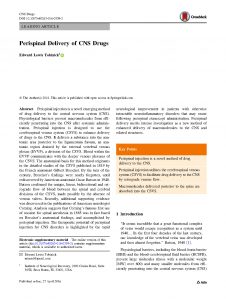From Iceland, A Message of Hope. Perispinal Etanercept Treatment by Edward Tobinick M.D. at the INR Boca Raton enables return to work after stroke. Text, images and video © 2018, INR PLLC, all rights reserved.
Disclaimer: Individual results vary, not all patients respond. Additional doses may be necessary to maintain the clinical response. Treatment is innovative (“off-label”). Terms of Use




 May 2, 2016 (Los Angeles, Boca Raton): On April 27, 2016, the peer-reviewed review article entitled, Perispinal Delivery of CNS Drugs, by Edward Tobinick MD, published online in the scientific journal CNS Drugs. The article published in print in the June issue of the journal. The abstract of the article states:
May 2, 2016 (Los Angeles, Boca Raton): On April 27, 2016, the peer-reviewed review article entitled, Perispinal Delivery of CNS Drugs, by Edward Tobinick MD, published online in the scientific journal CNS Drugs. The article published in print in the June issue of the journal. The abstract of the article states: